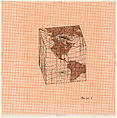Study of Distortions; Isometric Systems in Isotropic Space-Map Projections: The Cube
Agnes Denes American, born Hungary
Not on view
Born in Budapest, Hungary, Agnes Denes was educated in Sweden and the United States. She began her career as a painter, but has since expanded her activities to encompass a wide range of media, including drawing, printmaking, photography, site-specific sculpture, and environmental art. Although she does not fit neatly into any specific school, her philosophical approach and grid motifs align her with Conceptual Art and Minimalism. This intriguing drawing reflects her characteristic application of science to artistic expression and her concern for aesthetic presentation. While the viewer may not fully comprehend the intellectual content of her image, he or she can appreciate its beautiful execution and unusual analysis of form and space. Study of Distortions: Isometric Systems in Isotropic Space is typical of the topographical motifs Denes had been producing since the late 1960s. Here, she offers an alternate perception of space and time by projecting a section of the globe onto a cubic framework. The drawing is actually made up of two pieces—a sheet of graph paper underneath on which a map is painted with watercolor, and a clear plastic leaf on which a cube is precisely penned and gridded. As the artist states, she is "working with a paradox, defining the elusive, visualizing the invisible, communicating the incommunicable. . . " Such projects were never meant to be realized in three dimensions, but their visionary images spur us to think about the world in a new way and contemplate our place in it.
Due to rights restrictions, this image cannot be enlarged, viewed at full screen, or downloaded.


